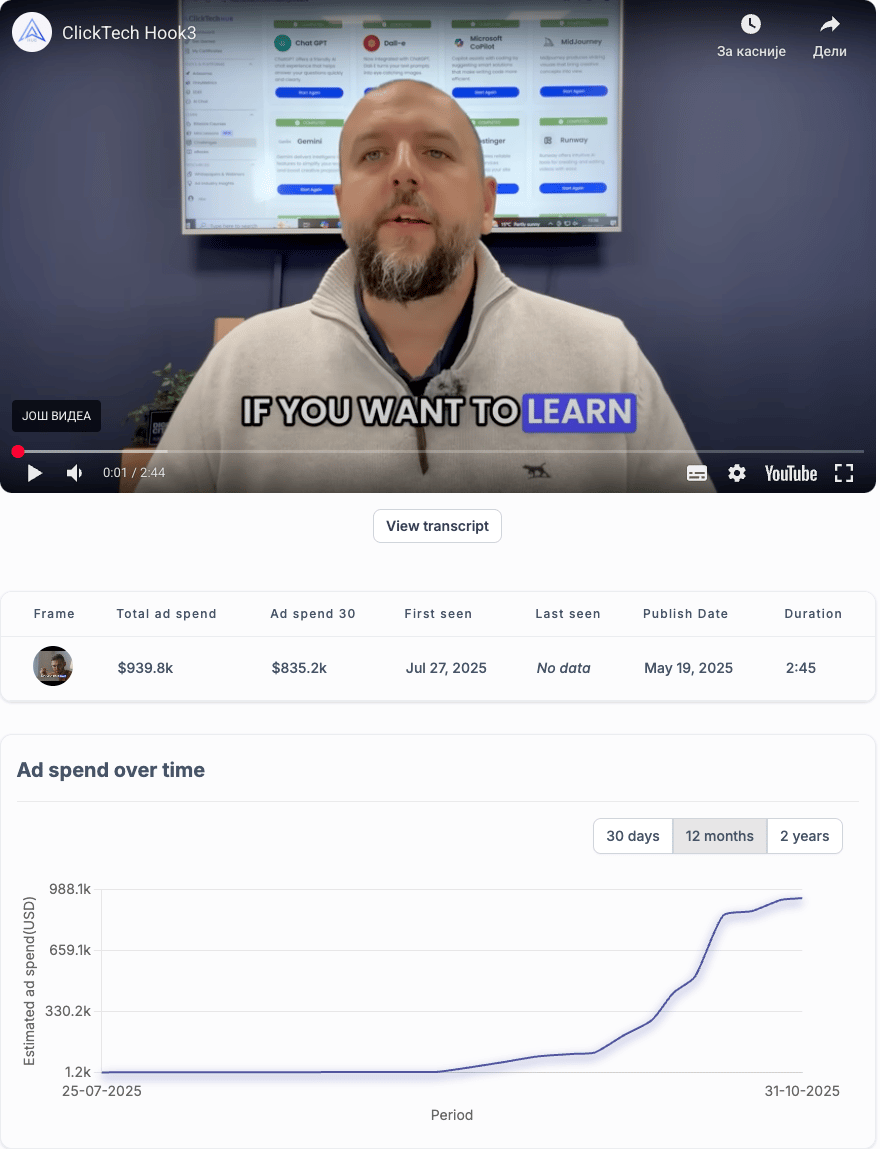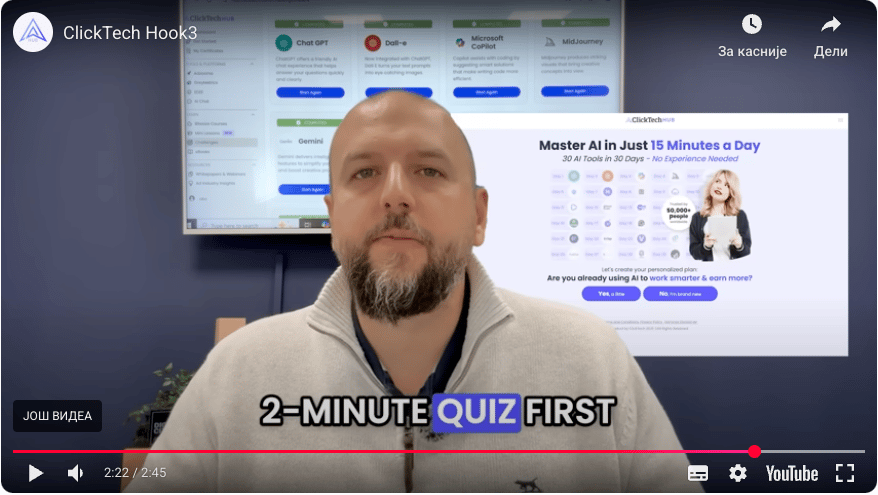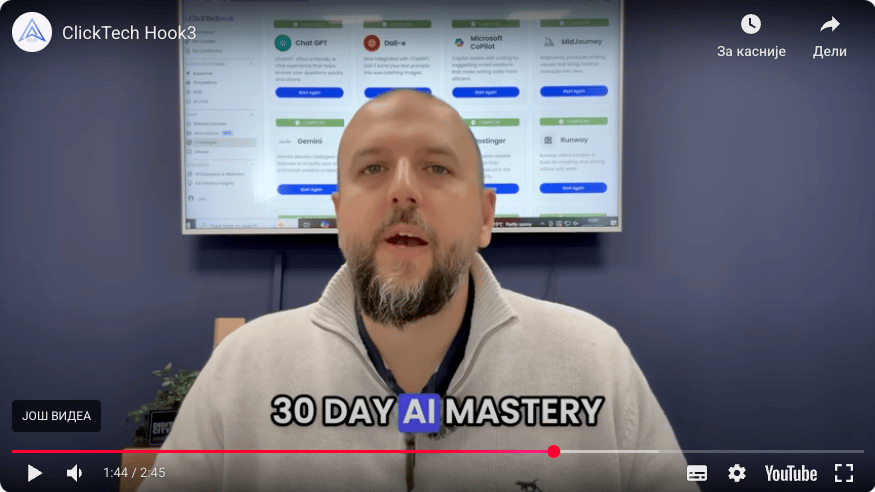- Inceptly
- Posts
- Fear, clarity, and a 30-day promise: the offer psychology behind a $940k ad
Fear, clarity, and a 30-day promise: the offer psychology behind a $940k ad
Hey there, everyone! So, let's talk about yet another ad that's been performing really well on YouTube! |  Author: |
It's for Click TechHub's 30-day AI Mastery Challenge, and what makes it interesting is how straightforward it is. We're talking simple UGC/presenter authority figure style - just a person sitting at a desk, talking to the camera.
And, as we all already know, when we see that, we know that the messaging has to be super tight. So, let's analyze it 🙂
Want to brainstorm with us on new ways to scale your business with YouTube Ads (and other performance video platforms)?
Join us for a free YouTube ad brainstorming session here:
First, the hook: "If you want to learn how to master using AI, don't watch YouTube videos." It's counterintuitive, especially since this is literally a YouTube ad. That contradiction grabs attention immediately.
The ad quickly identifies a common problem: information overload. Anyone who's tried to learn about AI online knows this feeling. Too many videos, too many tutorials, and before you know it, you're paralyzed by choice and haven't actually learned anything.
David Sharp introduces himself and establishes credibility early. He's not just some random person; he's the cofounder of a company that's helped 50,000+ people. That's social proof right there.
The "30-day AI Mastery Challenge" is a smart branding move. It's specific, time-bound, and sounds achievable. Not "become an AI expert" but "master AI in 30 days" - there's a big psychological difference.
They're tapping into a real fear here: the "great AI layoff." It's relatable and effective. The threat of becoming obsolete is a powerful motivator.
What's clever is how they address common objections. Don't have much time? The lessons are bite-sized. Worried it won't fit your needs? They've got a customized plan. They're removing barriers before viewers even think of them.
The two-minute quiz is a smart lead generation tactic. It's low commitment, personalized, and gives them valuable data about their audience. Plus, it makes the viewer feel like they're getting something tailored to them, not just a generic course.
They're painting a clear picture of the benefits: get more done, better work-life balance, increased earning potential, and job security. These aren't vague promises; they're specific outcomes people care about.
The urgency is woven throughout. "The longer you wait, the higher the chances of you becoming obsolete." It's not a countdown timer or limited spots, but it's creating a sense that delaying has real consequences.
Notice how they repeat the call to action multiple times, each time with slightly different framing. "Click the link to take the quiz" becomes "find the right plan for you" becomes "start your AI journey." Same action, different angles.
The ad also does a good job of making the challenge seem manageable. "Just 10 minutes a day" or "a few hours a week" - they're meeting people where they are, not demanding a massive time commitment upfront.
What's particularly effective is how they position AI skills as both defensive (don't get laid off) and offensive (increase your earning potential). They're covering both fear and aspiration.
So, what can we learn from this?
Challenge conventional wisdom: Starting with "don't watch YouTube videos" on YouTube is bold and attention-grabbing.
Identify the real problem: It's not that people don't want to learn AI; it's that they're overwhelmed by where to start.
Establish credibility quickly: Numbers matter. 50,000+ people helped is more convincing than vague claims.
Make it specific and time-bound: "30 days" is more compelling than "learn AI."
Address objections proactively: Time constraints, personalization needs - tackle them before they become reasons not to act.
Use a quiz as a lead magnet: It's interactive, personalized, and gives you valuable data.
Paint both fear and aspiration: Show what they'll lose if they don't act and what they'll gain if they do.
Make it manageable: Break down the commitment into bite-sized pieces.
Repeat the CTA: Don't be afraid to ask multiple times, as you can frame it differently each time.
This ad again proves that you don't need flashy production to create an effective campaign. A simple desk setup with a person talking directly to the camera can work wonders if the copy is strong and the offer is compelling.
In the world of online education and skill-building, the biggest barrier isn't usually price or time - it's overwhelm. This ad tackles that head-on by positioning their challenge as the antidote to information overload.
Remember, in direct response advertising, it's about understanding your audience's pain points and presenting your solution as the clear path forward. This ad nails that by acknowledging the problem (too much scattered information) and offering a structured solution (a 30-day challenge with bite-sized lessons).
What's also worth noting is the production simplicity. This isn't a high-budget ad with multiple locations, fancy graphics, or elaborate editing. It's just David at a desk, talking to the camera. And that works in their favor. It feels authentic, like a colleague giving you advice rather than a company trying to sell you something.
The UGC style has become increasingly effective in recent years, particularly for educational products. People are tired of overly polished ads that feel disconnected from reality. They want to hear from real people who understand their struggles.
This ad also does something smart with its pacing. It doesn't rush through the information. David takes his time explaining the problem, the solution, and the benefits. This longer format (over 2 minutes) allows for a more thorough pitch, which is appropriate for a product that requires some commitment.
The structure is worth examining, too. They follow a clear pattern: problem identification, credibility establishment, solution presentation, benefit explanation, objection handling, and repeated calls to action. It's a textbook direct response structure, but executed in a conversational way that doesn't feel formulaic.
One thing that stands out is how they've positioned AI learning not as a nice-to-have skill, but as essential for survival in the modern workplace. This isn't about getting ahead; it's about not getting left behind. That's a powerful reframe.
The customization angle is particularly clever. By offering a personalized plan based on a quiz, they're acknowledging that one-size-fits-all doesn't work. This makes the offer feel more valuable and increases the likelihood of conversion.
Here's what you should take away from this ad:
Simple production can be powerful: Don't let lack of budget stop you from creating effective ads.
Address the real barrier: For AI learning, it's not lack of interest; it's overwhelm.
Structure matters: Follow a clear progression from problem to solution to benefits.
Personalization sells: Offering customized plans makes your offer more appealing.
Use fear and aspiration: Show both what they'll avoid and what they'll gain.
Make the commitment manageable: Break it down into small, achievable steps.
Establish credibility early: Don't wait until the end to prove you're legitimate.
Repeat your CTA: Multiple asks, different framings, same action.
We all see a lot of ads trying to sell educational products, and many of them make the mistake of focusing too much on features (what's included in the course) rather than outcomes (what you'll be able to do after). This ad gets the balance right.
If you're selling any kind of skill-building product or service, take a page from this playbook. Identify the real barrier preventing people from learning (it's often overwhelm, not lack of interest), position your solution as the structured path forward, and make it feel manageable and personalized.
Remember, in the current state of the internet and the world, people are drowning in information. What they need isn't more content; it's a clear path through the noise. That's what this ad offers, and that's why it works.
Now, if you're looking to create ads that cut through the clutter and speak directly to your audience's real pain points, you know where to find us. We're always excited to help businesses craft YouTube ads that don't just get views but drive real results.
Until next time, keep it simple, keep it real, and remember - sometimes the best ads are the ones that feel the least like ads.
Cheers,
Alex and the Inceptly Team
🎯 Inceptly’s top picks:
Essential reading you can't afford to skip
The world of e-commerce is about to flip, and most brands won’t see it coming.
A silent shift is taking over your feed - changing how shoppers engage, what ads break through, and who wins. Are you ready for the “quiet feed revolution”?
👉 Read the full article to stay ahead before it hits full force.
A single sentence transformed what looked like another forgettable YouTube ad into a six-figure winner. No big production, no fancy effects - just one powerful line that flipped the entire campaign’s performance.
In this breakdown, we uncover why it worked and what every advertiser can learn from it.
Want to brainstorm with us on new ways to scale your business with YouTube Ads (and other performance video platforms)?
Join us for a free YouTube ad brainstorming session here:
 | Alex Simic, Creative Director Alex Simic is the person responsible for all creative work that stands behind Inceptly since stepping into his role in 2022. He comes from the role of the Media Buying Team Lead and Strategist behind some of Inceptly’s biggest successes. He has collaborated with the biggest names in the Direct Response industry, whether as a Senior Account Manager & Media Buyer or Creative Director. His main goal is bridging the gap between Media Buying and Creative, ensuring that the videos Inceptly produces are data-based and giving our clients the best chance at achieving success. |
Get in touch with us by responding to this email or tagging us on LinkedIn or Instagram and sharing your thoughts. Your feedback helps us keep our newsletter relevant and interesting.






